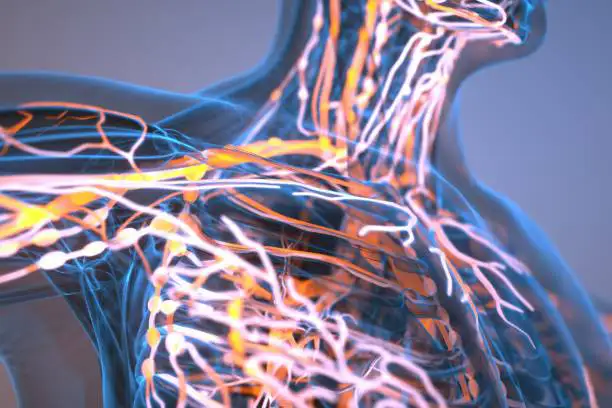Everyone talks about gut health, hormones, and inflammation, but few talk about the nerve that connects them all.
The vagus nerve is an often overlooked part of the parasympathetic nervous system, a.k.a. our “rest and digest” system. When it’s working well, your vagus nerve supports your natural ability to heal. When it’s not, you may struggle to get back to normal after an illness, trauma, or injury.
The reason lies in the way chronic illness stresses out your nervous system. After a while, illness turns on the sympathetic “fight or flight” nervous system. And even if you address the root cause of the illness, your body still thinks you’re in danger.
Why?
Your body wants to make sure you are safe. So, it keeps you in survival mode. And survival mode doesn’t prioritize healing—it prioritizes safety.
When your nervous system perceives a threat (even after the actual threat is gone), it keeps you on high alert. Muscles stay tense. Digestion slows. Inflammation lingers. Energy gets diverted away from healing.
That’s where the vagus nerve comes in. As the main communicator of your parasympathetic nervous system, it acts like a reset button—signaling to your brain and body that it’s safe to relax, digest, and heal. When the vagus nerve is activated, your body begins to shift out of fight-or-flight and into rest-and-repair.
So what makes this nerve so powerful—and why is it so often overlooked?
What is the Vagus Nerve and Why Does It Matter?
The vagus nerve (Latin for “wandering”) is the 10th cranial nerve, and it earns its name by meandering from the brainstem through the neck, heart, lungs, and into the digestive tract.

- Calm, steady moods
- Deep, restorative sleep
- Healthy digestion
- Lower inflammation
- Greater emotional resilience
- Anxiety or panic attacks
- IBS or other gut dysfunction like GERD
- Migraines
- Brain fog
- Chronic fatigue
- Heart rate variability (HRV) imbalance
- Autoimmune flares
- Persistent inflammation
At-Home Vagus Nerve Healing Exercises
You don’t need fancy tools or expensive programs to improve your vagal tone—though they can be helpful. What matters most is consistent, gentle effort to regulate your nervous system. The goal is to send your body clear signals that it’s safe. Simple practices like breathwork, meditation, movement, and massage are some of the most effective ways to do that.1. Breathwork
Breathing deeply—especially with prolonged exhales—stimulates the vagus nerve and signals the brain that you’re safe. Here are a few breathwork exercises to try:- Box breathing: Inhale for a count of 4, hold for 4, exhale for 4, hold for 4
- Extended exhale: Inhale for a count of 4, exhale for a count of 6–8
- Buteyko Breathing: Gentle breaths through your nose to slow down the breath, improve oxygen use, and support your vagus nerve.
2. Meditation & Mindfulness
Meditation helps regulate both the vagus nerve and emotional brain centers. Different styles offer different benefits:- Loving-Kindness Meditation: A heart-centered practice that fosters compassion and safety. Repeating phrases like “May I be safe, may I be well” enhances vagal tone by calming emotional centers.
- Body Scan Meditation: Brings attention to the sensations in your body, moving progressively from head to toe. It activates interoception, reduces hypervigilance, and increases mind-body connection.
- Mindfulness Meditation: The act of non-judgmentally observing the present moment—breath, sounds, thoughts. Helps quiet the default mode network and boosts vagus activity.
3. Cold Exposure
Cold stimulation can rapidly tone the vagus nerve by activating the diving reflex, a powerful parasympathetic trigger. Your body’s natural response to being submerged in cold water is to slow down your heart rate and lower your stress response.
Try:
- Splashing your face with cold water
- Adding 2 minutes of cold water for every 10 minutes of hot water during your showers.
- Full-body cold plunges or ice baths
- Placing hands or feet in cold water (great for a gentle reset)
Always begin slowly and consult with your healthcare provider, especially if you have cardiovascular concerns.
Humming, Singing & Gargling
These vibrational techniques activate the vagus by stimulating the nerves in your throat and vocals. Singing in the car or gargling vigorously before meals can be deceptively powerful.
Chanting
Chanting—especially prolonged vocalizations like “Om” or mantra repetition—creates rhythmic vocal cord vibrations that directly stimulate the vagus nerve. Studies have shown that chanting can slow the heart rate, increase HRV, and induce a meditative, parasympathetic state. This practice combines breath control and intentional sound, making it a potent way to regulate the nervous system and cultivate emotional resilience.
Vagus Nerve Massage
Gently massaging behind the ears, under the jaw, or along the sides of the neck (carotid sheath) can activate vagus pathways and release tension.
Movement & Somatic Practices
Slow, mindful movement such as yoga, Tai Chi, or Qi Gong grounds the nervous system. Walking in nature, dancing, or rebounding also help regulate vagal tone.
All of these techniques are powerful at-home healing for your vagus nerve. But sometimes, it may not be enough to take your body completely out of fight-or-flight. In those cases, you might look into professional support to improve vagal tone.
Professional Support for Vagus Nerve Healing
For those who have been suffering from chronic illnesses, professional healing modalities like bioelectrical stimulation and limbic retreating can help you access your parasympathetic nervous system more easily.
Here are a few of the ones we recommend to our patients at Boulder Holistic Functional Medicine.
Bioelectrical Devices for Vagus Nerve & Nervous System Support
These bioelectrical devices are non-invasive and can help nudge your nervous system into healing mode:
- Truvaga & Pulsetto: Neck-worn tVNS devices to boost vagal tone, improve HRV, and reduce stress.
- Alpha-Stim: Ear-clip microcurrent device for anxiety, pain, and sleep.
- Sensate: Chest-worn infrasonic vibration device to deepen relaxation.
- Apollo Neuro: Wrist/ankle device using vibration to shift nervous system states.
- FSM (Frequency-Specific Microcurrent): Low-level currents that support vagus repair, inflammation reduction, and fatigue recovery.
Limbic System Retraining Programs
These programs are designed to rewire the brain out of chronic stress, illness loops, and trauma responses. They often complement vagal work beautifully.
- DNRS & Gupta Program: Use visualization, mindfulness, and repetition to calm the limbic system and support recovery from chronic fatigue, long COVID, and more.
- Safe and Sound Protocol (SSP): Auditory therapy that uses filtered music to support vagus nerve healing.
- Primal Trust Academy: Combines somatic tools, polyvagal theory, and parts work for trauma and chronic illness healing.
These programs teach the brain and body how to feel safe, calm, and connected, which is the foundation for sustainable healing.
What Happens to Your Body When You Reset the Vagus Nerve?
You know that feeling when you’re laying down in your bed at the end of a long day. Everything is put away, the dishwasher is running, kids are asleep, and the second your head hits the pillow, you fall into a deep and restful sleep?
That’s what you have to look forward to when you reset your vagus nerve.
Working with the vagus nerve helps send a message to your body, “You’re safe to relax.” Your nervous system calms down, your heart rate slows, your digestion improves, and your body can finally focus on healing instead of just surviving.
Essentially, your body stops waiting for the other shoe to drop—and starts remembering what it feels like to just be.
Development and Regeneration of the Vagus Nerve
The vagus nerve is incredibly adaptable. It develops relatively early, but it changes constantly in response to how we live, move, breathe, and connect.
So, is vagus nerve damage reversible?
Absolutely. It’s never too late to start working on your vagal tone. Even after periods of chronic stress or illness, the vagus nerve has the capacity to repair itself.
Consistent practices like deep breathing, meditation, cold exposure, and gentle movement can strengthen your vagal tone and rewire the nervous system toward safety and healing.

Work with Boulder Holistic to Heal Your Vagus Nerve Naturally
Your vagus nerve is an essential part of healing, affecting how much time you spend in fight-or-flight versus rest-and-digest. If you’re ready to heal with your vagus nerve, contact us to schedule a consultation! We’ll guide you toward the best healing modality for you and give you tips as you follow your unique path to wellness.







